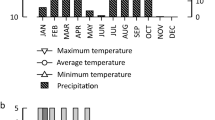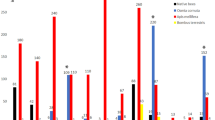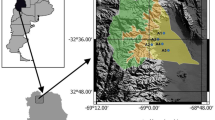Abstract
This research evaluates the impact of agricultural intensification on the recruitment, of managed versus wild pollinators in north-east (NE) Bulgaria. We investigated the spectrum and activity of pollinators in lavender mono-crop fields versus those in an ornamental lavender plantation. The pollinator visitation activity in the agrarian study sites was several times lower compared with the ornamental site. Additionally, honey bees outnumbered the wild bees there. In the ornamental site, more than 15 taxa of wild bees were recorded. Bombus haematurus (Kriechbaumer 1870), Amegilla sp., Thyreus sp., Andrena sp., Megachile melanopyga (Costa, 1863), M. cf. centucularis, Megachile cf. ericetorum, Osmia sp., Stelis cf. nasuta, Halictus sp., Lasioglossum spp., Hylaeus sp. and some other insects such as butterflies and hoverflies were recorded there together with the managed Apis mellifera, the latter with sporadic visits. The ornamental site neighbours Natura 2000 Pannonic sand steppes (6260), which explains the high biodiversity of the bee fauna. Intensive agriculture negatively affects the bees and particularly the wild bees. Even the honeybees suffer from the pesticides according to the local beekeepers. Our research shows that the control of human-created stressors needs to be optimized.



Similar content being viewed by others
References
Anonymous (2022) Operational analysis for major agricultural crops 30. Ministry of Agriculture of Bulgaria (in Bulgarian) https://www.mzh.government.bg/media/filer_public/2022/07/28/operativen_analiz_2022-07-27_ZiA805x.pdf [Accessed on 19.08.2023]
Balfour NJ, Garbuzov M, Ratnieks FL (2013) Longer tongues and swifter handling: Why do more bumble bees (Bombus spp.) than honeybees (Apis mellifera) forage on lavender (Lavandula spp.). Ecol Entomol 38(4):323–329. https://doi.org/10.1111/een.12019
Bauer AA, Clayton MK, Brunet J (2017) Floral traits influencing plant attractiveness to three bee species: consequences for plant reproductive success. Am J Bot 104:1–10
Benachour KK (2017) Insect visitors of lavender (Lavandula officinalis L.): Comparison of quantitative and qualitative interactions of the plant with its main pollinators. African Entomol 25(2): 435–444. https://hdl.handle.net/10520/EJC-9e3071d3f
Boyer KJ, Fragoso FP, Dieterich Mabin ME, Brunet J (2020) Netting and pan traps fail to identify the pollinator guild of an agricultural crop. Sci Rep 10(1):13819. https://doi.org/10.1038/s41598-020-70518-9
Cameron SA, Sadd BM (2020) Global trends in bumble bee health. Annu Rev Entomol 65:209–232. https://doi.org/10.1146/annurev-ento-011118-111847
Cole LJ, Kleijn D, Dicks LV, Stout JC, Potts SG, Albrecht M, Scheper J (2020) A critical analysis of the potential for EU Common Agricultural Policy measures to support wild pollinators on farmland. J Appl Ecol 57(4):681–694. https://doi.org/10.1111/1365-2664.13572
Crișan I, Ona A, Vârban D, Muntean L, Vârban R, Stoie A, Mihăiescu T, Morea A (2023) Current trends for Lavender (Lavandula angustifolia Mill.) Crops and products with emphasis on essential oil quality. Plants 12:357–386. https://doi.org/10.3390/plants12020357
Dafni A (1992) Pollination ecology: a practical approach. Oxford University Press, NY, USA, p 274
Dimitorv P, Dimitrova Z (1991) Studies on the pollinators of alfalfa fields for seed production in NE Bulgaria. Agr Sci 29 (4–6): 90–93 (in Bulgarian language))
Dimitorv P, Dimitrova Z, Piskov R (1991) Density of honeybees (Apis mellifera L.) on rows of self-pollinated sunflower line 2607 in seed production of Albena hybrid. Hella 17(21):53–56
Gilpin AM, Denham AJ, Ayre DJ (2017) The use of digital video recorders in pollination biology. Ecol Entomol 42(4):383–388. https://doi.org/10.1111/een.12394
Giray FH (2018) An analysis of world lavender oil markets and lessons for Turkey. J Ess Oil Bear Pl 21(6):1612–1623. https://doi.org/10.1080/0972060X.2019.1574612
Girotti S, Ghini S, Ferri E, Bolelli L, Colombo R, Serra G, Sangiorgi S (2020) Bioindicators and biomonitoring: honeybees and hive products as pollution impact assessment tools for the Mediterranean area. Euro-Mediterran J Environ Integ 5:1–16. https://doi.org/10.1007/s41207-020-00204-9
Goulson D, Nichollsp E, Botías C, Rotheray EL (2015) Bee declines driven by combined stress from parasites, pesticides, and lack of flowers. Science 347(6229):e1255957. https://doi.org/10.1126/science.1255957
Kozhuharov S, Dimitrov D, Kozhuharova E, Lazarova M (2001) Notes on the flora of the rocky limestone coast near the village of Kamen brjag – Jailata (NE Bulgaria). Ot Sistematik Botanik Dergisi 8(1):15–27
Kozuharova E, Simeonov V, Batovska D, Stoycheva C, Valchev H, Benbassat N (2023) Chemical composition and comparative analysis of lavender essential oil samples from Bulgaria in relation to the pharmacological effects. Pharmacia 70(2):395–403. https://doi.org/10.3897/pharmacia.70.e104404
Li C (2021) Understanding, Conservation, and Protection of Precious Natural Resources: Bees. In: Wang LK, Wang MHS, Hung YT, Shammas NK (eds) Environmental and natural resources engineering. handbook of environmental engineering, vol 19. Springer, Cham. https://doi.org/10.1007/978-3-030-54626-7_1
Matias D, Leventon J, Rau AL et al. (2017) A review of ecosystem service benefits from wild bees across social contexts. Ambio 46:456–467. https://doi.org/10.1007/s13280-016-0844-z
NCSS 2024 Statistical Software (2024). NCSS, LLC. Kaysville, Utah, USA, ncss.com/software/ncss (Accessed 10.02.2024)
Nicholson CC, Knapp J, Kiljanek T et al. (2023) Pesticide use negatively affects bumble bees across European landscapes. Nature. https://doi.org/10.1038/s41586-023-06773-3
O’Connor RS, Kunin WE, Garratt MP, Potts SG, Roy HE, Andrews C, Carvell C (2019) Monitoring insect pollinators and flower visitation: The effectiveness and feasibility of different survey methods. Meth in Ecol and Evol 10(12):2129–2140
Parreño MA, Alaux C, Brunet JL, Buydens L, Filipiak M, Henry M, Leonhardt SD (2022) Critical links between biodiversity and health in wild bee conservation. Trends in Ecol Evol 37(4):309–321. https://doi.org/10.1016/j.tree.2021.11.013
Radev Z (2023) Honey Bee (Apis mellifera L.) Pollination as an ecological method to increase the quality of lavender essential oil. Agriculturae Conspectus Scientificus 88(1):85–88
Reverté S, Miličić M, Ačanski J, Andrić A, Aracil A, Aubert M, Vujić A (2023) National records of 3000 European bee and hoverfly species: a contribution to pollinator conservation. Insect Conserv Diversity 16(6):758–775. https://doi.org/10.1111/icad.12680
Rundlöf M, Andersson GK, Bommarco R, Fries I, Hederström V, Herbertsson L et al. (2015) Seed coating with a neonicotinoid insecticide negatively affects wild bees. Nature 521(7550):77–80
Tzonev R, Dimitrov M (2006) The western-pontic steppe vegetation in Bulgaria. Hacquetia 5(1):5–23
Valchev H, Kolev Z, Stoykova B, Kozuharova E (2022) Pollinators of Lavandula angustifolia Mill., an important factor for optimal production of lavender essential oil. BioRisk 17:297–307. https://doi.org/10.3897/biorisk.17.77364
Williams NM, Hemberger J (2023) Climate, pesticides, and landcover drive declines of the western bumble bee. Proc Nat Acad Sci 120(7):e2221692120. https://doi.org/10.1073/pnas.2221692120
Zagorcheva T, Stanev S, Rusanov K, Atanassov I (2020) SRAP markers for genetic diversity assessment of lavender (Lavandula angustifolia mill.) varieties and breeding lines. Biotechnol Biotechnol Equip 34(1):303–308. https://doi.org/10.1080/13102818.2020.1742788
Acknowledgements
Ekaterina Kozuharoiva is grateful to the European Union – NextGenerationEU, through the National Recovery and Resilience Plan of the Republic of Bulgaria, project no. BG-RRP-2.004-0004-C01 for the financial support. Thank you to Zdravko Kolev for the identification of all butterflies. Thank you to Prof. Carlos Herrera for the help of identification of some bees.
Author information
Authors and Affiliations
Corresponding author
Additional information
Responsible Editor: Giulia Guerriero.
Rights and permissions
Springer Nature or its licensor (e.g. a society or other partner) holds exclusive rights to this article under a publishing agreement with the author(s) or other rightsholder(s); author self-archiving of the accepted manuscript version of this article is solely governed by the terms of such publishing agreement and applicable law.
About this article
Cite this article
Kozuharova, E., Vereecken, N.J. Lavender production in SE Dobrudja – intensive agriculture impacts pollinators’ density and diversity. Euro-Mediterr J Environ Integr (2024). https://doi.org/10.1007/s41207-024-00498-z
Received:
Accepted:
Published:
DOI: https://doi.org/10.1007/s41207-024-00498-z




